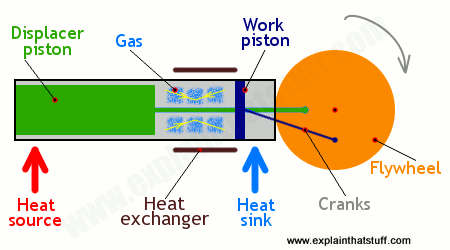
The Stirling engine, Invented by Robert Stirling in 1816, is a heat engine that is different from the internal-combustion engine in your everyday car. looking at a simplified Stirling engine. Our simplified engine uses two cylinders. One cylinder is heated by an external heat source (such as fire), and the other is cooled by an external cooling source (such as ice). The gas chambers of the two cylinders are connected, and the pistons are connected to each other mechanically by a linkage that determines how they will move in relation to one another.
The Stirling Principle

The main principle of a Stirling-engine is that, it has a fixed amount of gas sealed inside the engine. This cycle involves a series of events that change the pressure of the gas inside the engine, causing it to do work.
We have (4) parts to the Stirling cycle. The 2 pistons in the above image accomplishes all of the cycle:
at this stage heat is added to the gas inside the heated cylinder , causing pressure to buildup. This forces the piston to move down. which is the part of the Stirling cycle that does the major work.
Now, the left piston moves up while the right piston moves down, forcing the hot gas into the cooled cylinder, then it, quickly cools the gas to the temperature of the cooling source,decreasing its pressure. making it easier to compress the gas in the next part of the cycle.
during this cycle, the piston in the cooled cylinder, starts to compress the gas. heat generated by this compression is removed by the cooling source.
Finally the other piston moves up while the left piston moves down. forcing the gas into the heated cylinder,and it quickly heats up, building pressure, at this point the cycle repeats.
Hi! I am a robot. I just upvoted you! I found similar content that readers might be interested in:
https://auto.howstuffworks.com/stirling-engine1.htm